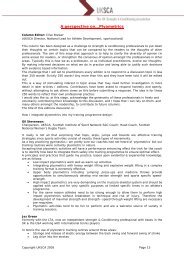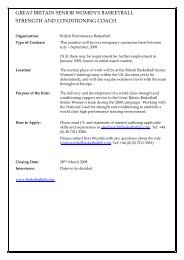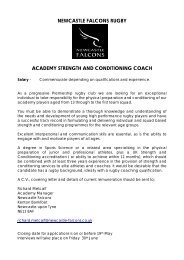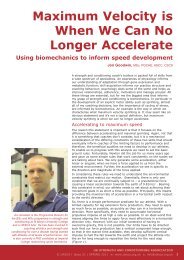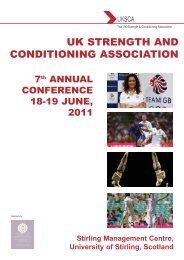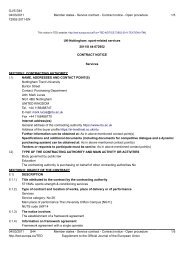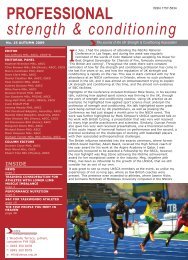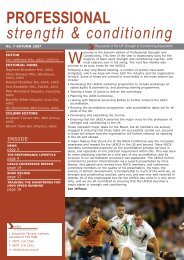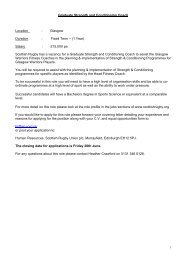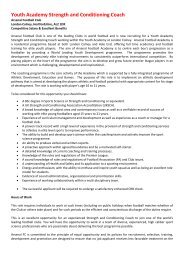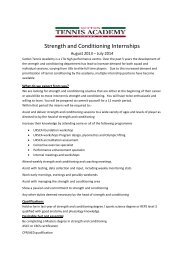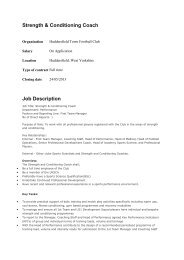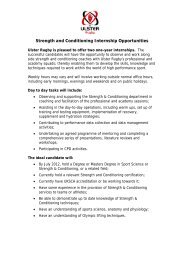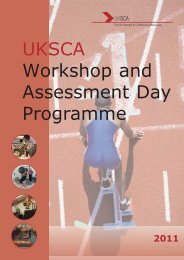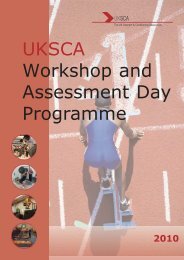uksca news june 2010.qxp
uksca news june 2010.qxp
uksca news june 2010.qxp
You also want an ePaper? Increase the reach of your titles
YUMPU automatically turns print PDFs into web optimized ePapers that Google loves.
Figure 2. The effects of vitamin C supplementation on<br />
changes in VO2max following 8 weeks of moderate<br />
endurance training in humans (personal communication,<br />
MC Gomez).<br />
on a battery of performance tests, notably 10K timetrial<br />
performance, in recreationally active males<br />
following a four week high-intensity interval training<br />
programme (Roberts et al, unpublished data).<br />
Intriguingly, similar results have been documented in<br />
rats following VC treatment. 30 On balance, you could<br />
say that cells have not signalled the end of antioxidant<br />
supplementation. Rather they have clouded the issue,<br />
with antioxidant supplementation appearing to impair<br />
training adaptations in untrained but not trained<br />
individuals. However, with the lack of evidence of<br />
improved performance, routine blanket<br />
supplementation in athletes appears expensive and<br />
unnecessary.<br />
N-acetylcysteine (NAC)<br />
From the discussion so far, antioxidant supplementation<br />
does not enhance or impair performance. The majority<br />
of the current literature has focused on VC and VE.<br />
Interestingly, re-synthesis of many endogenous<br />
antioxidants, notably glutathione peroxidise (GPX) and<br />
glutathione, is limited by cysteine availability. 4 The<br />
intracellular cysteine pool can be enhanced through<br />
NAC supplementation. 4 It follows that this<br />
enhancement could preserve the viability of<br />
endogenous antioxidant defences during exercise<br />
through increasing their resynthesis. Importantly, NAC<br />
supplementation has been shown to significantly<br />
improve fatigue resistance across several modes of<br />
study (see Figure 3). These findings indicate that ROS<br />
production may play a direct role in the process of<br />
muscular fatigue. 4<br />
In endurance-trained humans, NAC treatment<br />
(125mg·kg -1·h-1 ) pre-exercise and (15mg·kg -1·h-1 ) during<br />
exercise, prolongs time-to-exhaustion by around 20-<br />
25%. 15,16 Importantly, these studies used a randomised<br />
controlled cross-over design which enhances the<br />
robustness of their findings, since the subjects<br />
effectively acted as their own controls. One major<br />
issue with the studies that have investigated<br />
acute NAC treatment is that NAC was<br />
administered intravenously both before and<br />
during exercise. Suffice to say, this treatment<br />
strategy is invasive and impractical. These findings<br />
would be strengthened if they persisted after oral NAC<br />
supplementation; unfortunately, no study to date has<br />
been published demonstrating improved performance<br />
using oral NAC, and thus this hypothesis remains<br />
untested. Of equal importance, the long term effects of<br />
NAC treatment on performance are also unknown. It is,<br />
however, unlikely that chronic supplementation would<br />
benefit the athlete since the dramatic attenuation of<br />
ROS production observed following acute NAC<br />
treatment would likely hinder beneficial ROS signalling<br />
and thus impair training adaptation. We stress that this<br />
hypothesis has not been tested experimentally to date.<br />
Future directions<br />
It is becoming clear that VC and VE are unable to<br />
improve muscle performance and/or recovery and may<br />
even impair training adaptations. NAC is the only<br />
antioxidant that has consistently been shown to<br />
enhance short-term athletic performance. Future<br />
studies should try to tease out the role of acute oral<br />
supplementation in enhancing performance. NAC may<br />
inhibit training adaptation over a longer period.<br />
However, sport presents some unique situations in<br />
which the realisation of training adaptations is largely<br />
inconsequential. For instance, in the current football<br />
world cup, the enhancement of muscle recovery will<br />
take precedence over training adaptations, since the<br />
athletes will (hopefully) already be in optimal condition<br />
and the recovery time between exercise bouts is<br />
limited. It could be that NAC is able to increase<br />
recovery time between games in these situations. A<br />
similar example could be seen when considering a<br />
tennis competition, where games are often played<br />
every second day. To this end, we are currently<br />
investigating the effects of acute NAC supplementation<br />
on performance during a simulated soccer tournament.<br />
In addition, future studies should be undertaken to<br />
determine the effects of antioxidants supplementation<br />
in resistance trained athletes as our knowledge of this<br />
area is limited.<br />
Practical recommendations<br />
The answer to this question depends on the desired<br />
outcome of the supplementation, training status of the<br />
individual, time-course (acute or chronic) and the<br />
actual treatment used (VC, VE or NAC). In an attempt<br />
to properly address this question we have composed<br />
the following recommendations:<br />
1. Ensure athletes eat a well balanced diet rich in fruit<br />
and vegetables to provide sufficient exogenous<br />
antioxidants from good food sources. This should<br />
provide sufficient exogenous antioxidants even for<br />
athletes engaged in intense training. Athletes with a<br />
Figure 3. Positive effects of NAC on fatigue resistance<br />
across research models. The black bar indicates the<br />
minimum improvement whereas the grey indicates the<br />
maximum. References: in vitro 3,10,14,26 ; in situ 24 ; electrical<br />
stimulation 23 ; small-muscle mass [e.g. single joint<br />
exercise] 11,13,29 and large muscle mass [e.g. endurance<br />
running]. 15,16 Taken from Ferriera and Reid. 4<br />
UK STRENGTH AND CONDITIONING ASSOCIATION<br />
© UKSCA | Issue 18 | Summer 2010 w: www.<strong>uksca</strong>.org.uk e: info@<strong>uksca</strong>.org.uk 13



